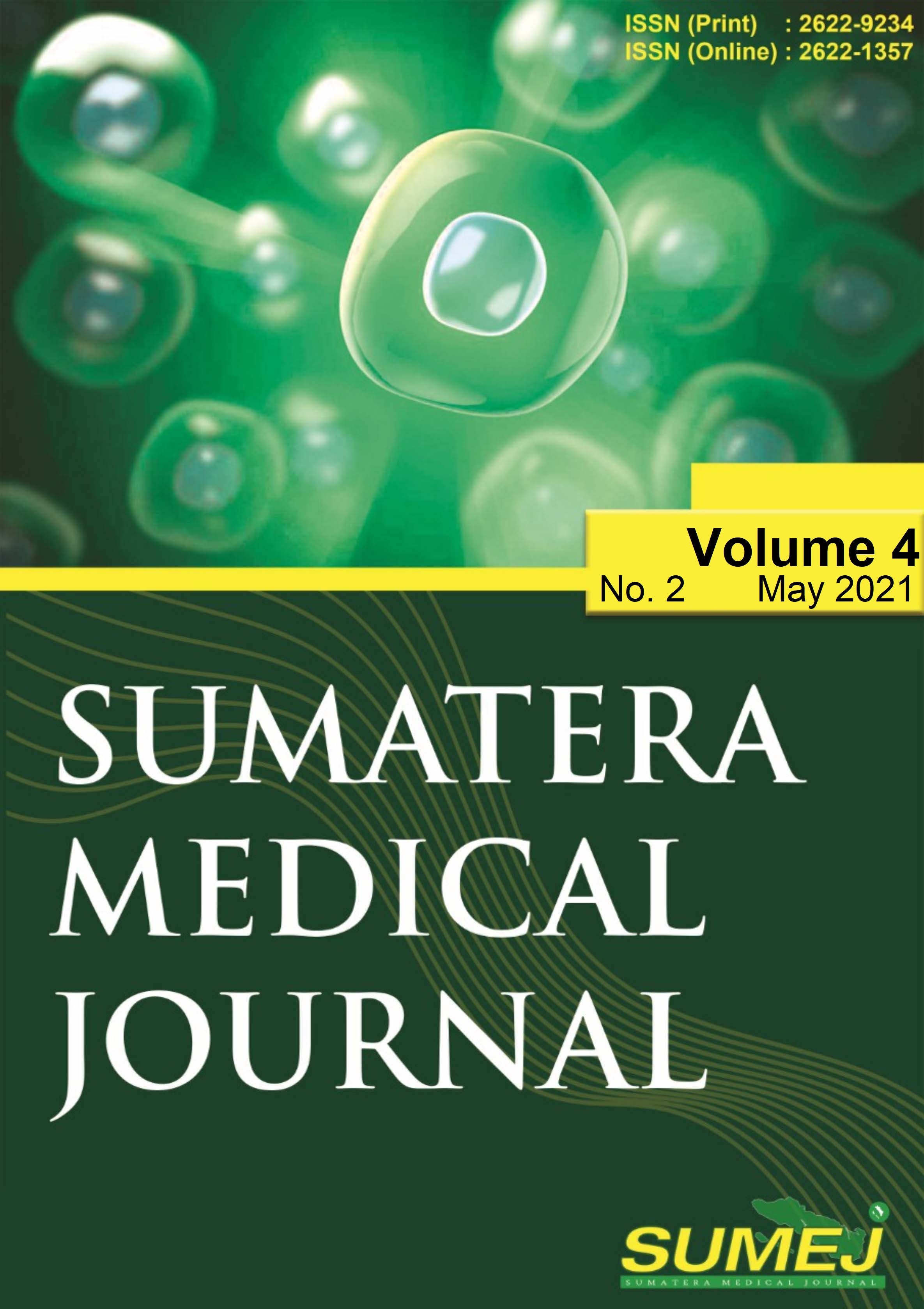The Relationship of ICH Score and 30-Day Mortality Rate in Hemorrhagic Stroke Patient: Systematic Review and Meta-Analysis
DOI:
https://doi.org/10.32734/sumej.v4i2.5717Keywords:
Hemorrhagic Stroke, ICH Score, Mortality RateAbstract
Hemorrhagic stroke is a type of stroke that causes more deaths than ischemic stroke. The prognosis of hemorrhagic stroke patients can be determined with ICH Score. ICH score has a value range of 0-6. The variables of ICH Score are GCS score (0-2), bleeding volume (0-1), intraventricular bleeding (0-1), infratentorial origin (0-1), and age (0-1). Aim: This meta-analysis study aims to determine the relationship between ICH Score and 30-day mortality rate in hemorrhagic stroke patients. Methods: This meta-analysis study uses online literature sourced from Pubmed, Science Direct and Google Scholar. Result: Based on data analysis, there is a significant relationship between the ICH Score and the mortality rate in hemorrhagic stroke patients (OR 18.04, 95% CI: 10.65; 30.55). Analysis of the ICH Score accuracy found that the ICH Score had high accuracy to predict the mortality of hemorrhagic stroke patients (AUC 0.827, 95% CI: 0.796; 0.858). Conclusion: ICH Score has a significant relationship with the 30-day mortality rate in hemorrhagic stroke patients and has high accuracy for predicting mortality in hemorrhagic stroke patients.
Downloads
References
World Health Organization, “Stroke: a global response is needed,†2016. https://www.who.int/bulletin/volumes/94/9/16-181636/en/ (accessed Apr. 03, 2020).
E. J. Benjamin et al., Heart Disease and Stroke Statistics-2019 Update: A Report From the American Heart Association, vol. 139, no. 10. 2019.
R. R. V Krishnamurthi et al., “Global and regional burden of first-ever ischaemic and haemorrhagic stroke during 1990–2010)70089-5. Global and regional burden of first-ever ischaemic and haemorrhagic stroke during 1990–2010,†Lancet. Glob. Heal., vol. 1, no. 5, pp. e259–e281, 2013, doi: 10.1016/S2214-109X(13)70089-5.Global.
Kementrian Kesehatan RI, “Riset Kesehatan Dasar (Riskesdas),†Litbankes Kemenkes RI, 2018.
S. T. Epple C, Brainin M, “Intracerebral hemorrhage,†in Textbook of stroke medicine, 2nd ed., H. W. Brainin M, Ed. Cambridge University Press, 2013, pp. 188–206.
N. Chaudhary, A. S. Pandey, X. Wang, and G. Xi, “Hemorrhagic stroke—Pathomechanisms of injury and therapeutic options,†CNS Neurosci. Ther., vol. 25, no. 10, pp. 1073–1074, 2019, doi: 10.1111/cns.13225.
R. Houben, F. H. B. M. Schreuder, K. J. Bekelaar, D. Claessens, R. J. van Oostenbrugge, and J. Staals, “Predicting prognosis of intracerebral hemorrhage (ICH): Performance of ICH score is not improved by adding oral anticoagulant use,†Front. Neurol., vol. 9, no. FEB, pp. 1–6, 2018, doi: 10.3389/fneur.2018.00100.
M. A. Rind, M. Ali, M. Nazir, and S. Sheikh, “Validity of Intracerebral Haemorrhge Score in Predicting Prognosis of Hemorrhagic Stroke,†vol. 11, no. 1, pp. 7–12, 2016.
A. Abdallah et al., “Validation of the intracerebral hemorrhage score in Uganda: A prospective cohort study,†Stroke, vol. 49, no. 12, pp. 3063–3066, 2018, doi: 10.1161/STROKEAHA.118.022057.
H. S. Chen, C. F. Hsieh, T. T. Chau, C. D. Yang, and Y. W. Chen, “Risk factors of in-hospital mortality of intracerebral hemorrhage and comparison of ICH scores in a Taiwanese population,†Eur. Neurol., vol. 66, no. 1, pp. 59–63, 2011, doi: 10.1159/000328787.
Y. C. Chuang, Y. M. Chen, S. K. Peng, and S. Y. Peng, “Risk stratification for predicting 30-day mortality of intracerebral hemorrhage,†Int. J. Qual. Heal. Care, vol. 21, no. 6, pp. 441–447, 2009, doi: 10.1093/intqhc/mzp041.
J. L. Clarke, S. C. Johnston, M. Farrant, R. Bernstein, D. Tong, and J. C. Hemphill, “External validation of the ICH score,†Neurocrit. Care, vol. 1, no. 1, pp. 53–60, 2004, doi: 10.1385/NCC:1:1:53.
A. Esmael, M. Sherif, and M. Saad, “Prediction of 30-days Mortality of Intracerebral Hemorrhage by a Powerful but Easy to Use Intracerebral Hemorrhage Score,†Int. Neuropsychiatr. Dis. J., vol. 6, no. 2, pp. 1–11, 2016, doi: 10.9734/indj/2016/22414.
J. S. Garrett, M. Zarghouni, K. F. Layton, D. Graybeal, and Y. A. Daoud, “Validation of clinical prediction scores in patients with primary intracerebral hemorrhage,†Neurocrit. Care, vol. 19, no. 3, pp. 329–335, 2013, doi: 10.1007/s12028-013-9926-y.
A. L. A. Garton, V. P. Gupta, S. Sudesh, H. Zhou, B. R. Christophe, and E. S. Connolly, “The Intracerebral Hemorrhage Score: Changing Perspectives on Mortality and Disability,†World Neurosurg., vol. 135, pp. e573–e579, 2020, doi: 10.1016/j.wneu.2019.12.074.
D. A. Godoy, G. Piñero, and M. Di Napoli, “Predicting mortality in spontaneous intracerebral hemorrhage: Can modification to original score improve the prediction?,†Stroke, vol. 37, no. 4, pp. 1038–1044, 2006, doi: 10.1161/01.STR.0000206441.79646.49.
J. C. Hemphill, D. C. Bonovich, L. Besmertis, G. T. Manley, and S. C. Johnston, “The ICH score: A simple, reliable grading scale for intracerebral hemorrhage,†Stroke, vol. 32, no. 4, pp. 891–896, 2001, doi: 10.1161/01.str.32.4.891.
V. Malinova, B. Iliev, D. Mielke, and V. Rohde, “Intracerebral Hemorrhage-Score Allows a Reliable Prediction of Mortality in Patients with Spontaneous Intracerebral Hemorrhage Managed by Fibrinolytic Therapy,†Cerebrovasc. Dis., vol. 48, no. 3–6, pp. 165–170, 2020, doi: 10.1159/000504246.
S. Muengtaweepongsa and B. Seamhan, “Predicting mortality rate with ICH score in Thai intracerebral hemorrhage patients,†Neurol. Asia, vol. 18, no. 2, pp. 131–135, 2013.
T. Nisar, A. Alchaki, and M. Hillen, “Validation of ICH score in a large urban population,†Clin. Neurol. Neurosurg., vol. 174, no. August, pp. 36–39, 2018, doi: 10.1016/j.clineuro.2018.09.007.
A. R. Parry-Jones et al., “Accuracy and clinical usefulness of intracerebral hemorrhage grading scores: A direct comparison in a UK population,†Stroke, vol. 44, no. 7, pp. 1840–1845, 2013, doi: 10.1161/STROKEAHA.113.001009.
G. C. Patriota et al., “Determining ich score: Can we go beyond?,†Arq. Neuropsiquiatr., vol. 67, no. 3 A, pp. 605–608, 2009, doi: 10.1590/S0004-282X2009000400006.
P. U.M. et al., “Validation of ICH and ICH-GS Scores in an Indian Cohort: Impact of Medical and Surgical Management,†J. Stroke Cerebrovasc. Dis., vol. 28, no. 8, pp. 2213–2220, 2019, doi: 10.1016/j.jstrokecerebrovasdis.2019.05.003.
F. Rahmani, R. Rikhtegar, A. Ala, A. Farkhad-Rasooli, and H. Ebrahimi-Bakhtavar, “Predicting 30-day mortality in patients with primary intracerebral hemorrhage: Evaluation of the value of intracerebral hemorrhage and modified new intracerebral hemorrhage scores.,†Iran. J. Neurol., vol. 17, no. 1, pp. 47–52, 2018, [Online]. Available: http://www.ncbi.nlm.nih.gov/pubmed/30186559%0Ahttp://www.pubmedcentral.nih.gov/articlerender.fcgi?artid=PMC6121209.
D. A. Safatli, A. Günther, P. Schlattmann, F. Schwarz, R. Kalff, and C. Ewald, “Predictors of 30-day mortality in patients with spontaneous primary intracerebral hemorrhage,†Surg. Neurol. Int., vol. 7, no. 19, pp. S510–S517, 2016, doi: 10.4103/2152-7806.187493.
J. L. Ruiz-Sandoval, E. Chiquete, S. Romero-Vargas, J. J. Padilla-MartÃnez, and S. González-Cornejo, “Grading scale for prediction of outcome in primary intracerebral hemorrhages,†Stroke, vol. 38, no. 5, pp. 1641–1644, 2007, doi: 10.1161/STROKEAHA.106.478222.
C. Weimar, J. Benemann, and H. C. Diener, “Development and validation of the Essen Intracerebral Haemorrhage Score,†J. Neurol. Neurosurg. Psychiatry, vol. 77, no. 5, pp. 601–605, 2006, doi: 10.1136/jnnp.2005.081117.
Downloads
Published
How to Cite
Issue
Section
License
Copyright (c) 2021 Sumatera Medical Journal

This work is licensed under a Creative Commons Attribution-NonCommercial-NoDerivatives 4.0 International License.
The Authors submitting a manuscript do so on the understanding that if accepted for publication, copyright of the article shall be assigned to Sumatera Medical Journal (SUMEJ) and Faculty of Medicine as well as TALENTA Publisher Universitas Sumatera Utara as publisher of the journal.
Copyright encompasses exclusive rights to reproduce and deliver the article in all form and media. The reproduction of any part of this journal, its storage in databases and its transmission by any form or media, will be allowed only with a written permission from Sumatera Medical Journal (SUMEJ).
The Copyright Transfer Form can be downloaded here.
The copyright form should be signed originally and sent to the Editorial Office in the form of original mail or scanned document.











